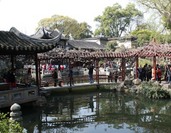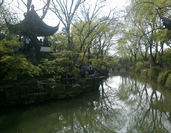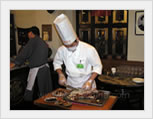
Lingering Garden Guide
-Travel to Lingering Garden Lingering Garden is located outside the Changmen gate of Suzhou, Jiangsu province. It was commissioned by Xu Taishi, an impeached and later exonerated official in 1593 CE. Stonemason Zhou Shicheng designed and built the East Garden as it was initially called. The East Garden became famous in its day when the magistrates of Wu and Changzhou County both praised the design of Shi Ping Peak, a rockery constructed to resemble Tiantai Mountain in Putao. Ownership passed to Liu Su, another official in 1798 CE. After extensive reconstruction, he renamed it Cold Green Village after a verse, "clean cold color of bamboo, limpid green light of water". Keeping with that theme, he added pine and bamboo groves. He was an avid collector of Scholar stones and added 12 more to the garden housing them in the "stone forest". It was also at this time the "Celestial Hall of Five Peaks" was built. The garden soon acquired the nickname "Liu Yuan" from the owner's surname. From 1823 CE the garden was open to public, and became a famed resort.
Lingering Garden is located outside the Changmen gate of Suzhou, Jiangsu province. It was commissioned by Xu Taishi, an impeached and later exonerated official in 1593 CE. Stonemason Zhou Shicheng designed and built the East Garden as it was initially called. The East Garden became famous in its day when the magistrates of Wu and Changzhou County both praised the design of Shi Ping Peak, a rockery constructed to resemble Tiantai Mountain in Putao. Ownership passed to Liu Su, another official in 1798 CE. After extensive reconstruction, he renamed it Cold Green Village after a verse, "clean cold color of bamboo, limpid green light of water". Keeping with that theme, he added pine and bamboo groves. He was an avid collector of Scholar stones and added 12 more to the garden housing them in the "stone forest". It was also at this time the "Celestial Hall of Five Peaks" was built. The garden soon acquired the nickname "Liu Yuan" from the owner's surname. From 1823 CE the garden was open to public, and became a famed resort.
 Ownership passed to Sheng Kang, a provincial treasurer of Hubei in 1873 CE. He repaired the damaged caused to the garden by the chaos of the Taiping. After three years the reconstruction was complete in 1876 CE, and the garden was renamed to Liu Yuan. The name, while homophonous to an older name, connotes leisure and is thus pays tribute to the former owner as well as the resort period of the garden. It was at this time the "Auspicious Cloud Capped Peak" stone was moved to its current location. The garden was inherited by Sheng Xuanhuai from his father, he abandoned the garden in 1911 and it fell into disrepairDuring Sino-Japanese War, the garden was abandoned again, and it even degenerated into breeding zone for army's horses. After establishment of the People's Republic of China, Suzhou government took over and renovated the garden. It was reopened to the public in 1954. In 2001 the garden was added to the UNESCO Word Heritage list, and remains a major tourist destination.
Ownership passed to Sheng Kang, a provincial treasurer of Hubei in 1873 CE. He repaired the damaged caused to the garden by the chaos of the Taiping. After three years the reconstruction was complete in 1876 CE, and the garden was renamed to Liu Yuan. The name, while homophonous to an older name, connotes leisure and is thus pays tribute to the former owner as well as the resort period of the garden. It was at this time the "Auspicious Cloud Capped Peak" stone was moved to its current location. The garden was inherited by Sheng Xuanhuai from his father, he abandoned the garden in 1911 and it fell into disrepairDuring Sino-Japanese War, the garden was abandoned again, and it even degenerated into breeding zone for army's horses. After establishment of the People's Republic of China, Suzhou government took over and renovated the garden. It was reopened to the public in 1954. In 2001 the garden was added to the UNESCO Word Heritage list, and remains a major tourist destination.
 The 23,310 m2 garden is divided into four distinctly themed sections; East, Central, West, and North. The Central area is the oldest part of the garden. Buildings, the primary feature of any Chinese garden, occupy one third of the total area. A unique feature this garden is the 700 m covered walk which connects them. The built elements of the garden are grouped by section. The ensemble of structures in the central garden encircles a pond and grotto main feature. The grotto is constructed of yellowstone granite and was created by the noted artist Zhou Binzhong. The Eastern section of the garden is arrayed around the cloud capped peak stone. A central courtyard is ringing by buildings. Behind the Old Hermit Scholars' House is the Small Court of Stone Forest, a collection of Scholar stones and connected minor courtyards. The western section is mostly natural containing only a few pavilions, a large artificial hill, and a Penzai garden.
The 23,310 m2 garden is divided into four distinctly themed sections; East, Central, West, and North. The Central area is the oldest part of the garden. Buildings, the primary feature of any Chinese garden, occupy one third of the total area. A unique feature this garden is the 700 m covered walk which connects them. The built elements of the garden are grouped by section. The ensemble of structures in the central garden encircles a pond and grotto main feature. The grotto is constructed of yellowstone granite and was created by the noted artist Zhou Binzhong. The Eastern section of the garden is arrayed around the cloud capped peak stone. A central courtyard is ringing by buildings. Behind the Old Hermit Scholars' House is the Small Court of Stone Forest, a collection of Scholar stones and connected minor courtyards. The western section is mostly natural containing only a few pavilions, a large artificial hill, and a Penzai garden.
More Attractions in Suzhou
- Water Town Tongli
- The Lingering Garden
- The Ancient Grand Canal
- The Master of Nets Garden
- Silk Embroidery Factory
- Tiger Hill
- Xuanmiao Taoist Temple
- Panmen Scenic Zone
- Shiquan Culture Street
- Zhouzhuang town
- Mountain Villa with Embracing Beauty
- The Garden of Cultivation
- Lingering Garden
- Suzhou Museum
- Lion Grove Garden
- Hanshan Temple
- Jinji Lake
- Shantang Street
Your Question & Quick Answer*We welcome and appreciate your questions & reviews
Booking Procedures | Terms & Conditions | Payment Methods | Links | Site Map | About Us | Contact Us | Travel Agent
Copyright 2008, All rights reserved.. itourbeijing.com professional china travel guide and china travel service
TEL: 86-10-85711972 (Universal) 1-888-288-9328 (North America) E-mail: contact@itourbeijng.com
Tours Index | China Tours | Beijing Tours | Xi'an Tours | Shanghai Tours | Guilin Tours | Tibet Tours
China Travel | Beijing Travel | Shanghai Travel | Xi'an Travel | Guilin Travel |Beijing Map
China Golf | Beijing Golf | Shanghai Golf | Xiamen Golf | The Great Wall Travel | Yangtze Cruise | Travel Picture



